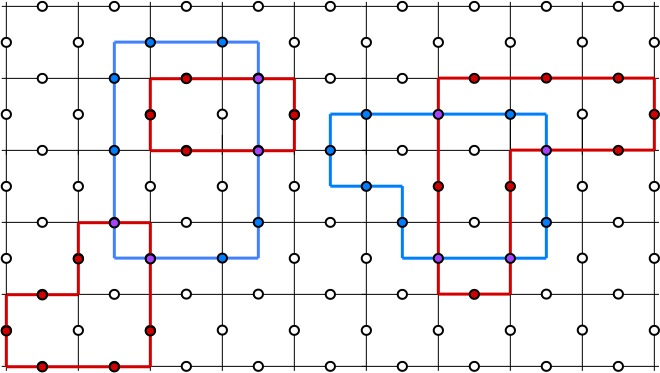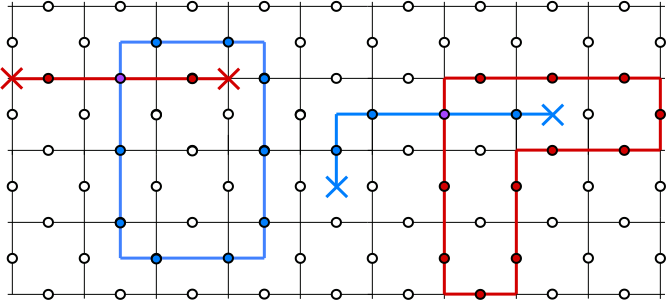Topological order and the toric code
Introduction
The topological order is introduced by Barbara Terhal from RWTH Aachen
Simplest model for topological degeneracy: Toric code
We have worked hard to create topological models so far. The FQH system, which is the most topological in some sense, was also more obscure in terms of microscopics. Here we will follow Alexei Kitaev and right down a simple Hamiltonian that is obviously topological, but also relatively easy to analyse.
The Hamiltonian we will write is that of a system of localized spin
As you can see in the figure below,
Particle-like excitations
As we saw in the FQH systems, excitations with fractional charge and statistics was really the hall-mark of topologically degenerate states. Since the basic degree of freedom in the toric code are spin, we expect all excitations to be neutral. But there is a possibility that we get fractionalized statistics. The neat thing about the toric code Hamiltonian is that it allows us to also compute not only can we figure out the ground state for the toric code but also all the excited states. Again, this is not too surprising since all the terms in the Hamiltonian commute, so all eigenstates are simultaneous eigenstates of the vertex and plaquette terms. If we focus on the vertex terms first (let's say by assuming that

Since

What if we focused on the large plaquette term limit i.e.
Returning to the
The ground state looks pretty non-degenerate at this point but if we consider the system with periodic boundary conditions - namely on a torus, we immediately see that there are 4 topologically distinct loop configurations that are degenerate. Basically, the plaquette terms can only deform the loops smoothly and therefore cannot change the parity of the winding numbers of the loops.
It is however possible to continuously deform a closed loop into a pair of loops along some cycle of the torus. So only the parity of the loop winding across a cut cannot be changed. Thus, the toric code on a torus has 4 degenerate ground state wave-functions (all with the same energy), which are topologically distinct. The difference between these wave functions is the parity of the number of loops crossing a vertical or a horisontal cycle on the torus.
Does this have anything to do with the way we have defined topology in this course, using the bulk-edge correspondence? Unfortunately and confusingly, not. These interacting systems are topological in the sense of possessing a topological degeneracy between topologically distinct states that cannot be continuously deformed into one another. In a sense, this is a more amazing feature than the bulk edge correspondence itself - the degeneracy between these states cannot be lifted by any reasonable (local) perturbation. This is sort of similar to Majorana fermions, but even more robust. In fact, the toric code does not even have edge states, so there is really no bulk-edge correspondence to speak of.
The topological robustness makes the topologically degenerate states particularly attractive to store quantum information. The main challenge of quantum information is the quantum decoherence problem, where local fluctuations in the Hamiltonian destroy the phase coherence of the quantum system used to store information. The solution proposed by topological quantum computation is to use the topologically degenerate space of a toric code to store the information. In fact, this is in essence what is being attempted by experimentalists who work on superconducting qubits, under the framework of the surface code.

While the intuitive picture for the excitations as ends of broken loops is nice, to describe these exctiation in the more general case where
By viewing the system in the
Therefore
We andWm are conserved 'flux' operators that measure the parity of the number of electric and magnetic defects inside the loopsle,m respectively.
Thus, the values
Just like in the quantum Hall effect, we can use the Wilson loops
Semionic statistics of excitations
The loop gas picture makes the 'e' and 'm' excitations, which are ends of loops look quite topological. But are they topological in a sense similar to the charges in the FQH system? To see this, let us try to interchange an 'e' particle and an 'm' particle. For starters let us see how to move each of these particles. To do this we use the 'path' operators
move an excitation from the points
Now, if we try to take an 'e' particle around an 'm' particle, the path forms a loop
Next we try to exchange a pair of 'e' particles. We can do this by applying a pair of path operators
Finally, if we exchange an 'e'-'m' pair with another 'e'-'m' pair, we see [Figure coming soon], that the result is equivalent to a double exchange between an 'e' particle and an 'm' particle in addition some 'e' and 'm' exchanges. The double exchange produces a



